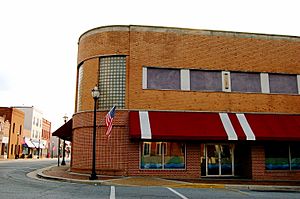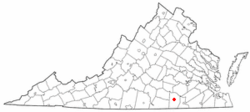Lawrenceville, Virginia facts for kids
Quick facts for kids
Lawrenceville, Virginia
|
|
|---|---|

Lawrenceville
|
|

Location of Lawrenceville, Virginia
|
|
| Country | United States |
| State | Virginia |
| County | Brunswick |
| Area | |
| • Total | 1.15 sq mi (2.98 km2) |
| • Land | 1.15 sq mi (2.98 km2) |
| • Water | 0.00 sq mi (0.00 km2) |
| Elevation | 266 ft (81 m) |
| Population
(2020)
|
|
| • Total | 1,014 |
| • Estimate
()
|
1 |
| • Density | 882/sq mi (340.3/km2) |
| Time zone | UTC−5 (Eastern (EST)) |
| • Summer (DST) | UTC−4 (EDT) |
| ZIP code |
23868
|
| Area code(s) | 434 |
| FIPS code | 51-44520 |
| GNIS feature ID | 1498503 |
Lawrenceville is a town in Brunswick County, Virginia, United States. In 2020, about 1,014 people lived there. It is located by the Meherrin River. Lawrenceville is the main town, or county seat, of Brunswick County.
Long ago, in colonial times, Governor Alexander Spotswood had a fort built nearby. It was called Fort Christanna. Native American allies who had become Christians lived and went to school there.
Saint Paul's College was started here in 1888. It was a college mainly for Black students and was connected to the Episcopal Church. The college operated until 2013.
Farmers in the area grow things like lumber, tobacco, and other farm products. They also raise livestock. Lawrenceville is in a county near the southern border of Virginia. This area is one of the northernmost places where cotton is grown.
Contents
History of Lawrenceville
Early Explorers and Fort Christanna
The first time Anglo colonists explored what is now Brunswick County was in 1650. During the 1600s and 1700s, the county grew by producing tobacco. This crop needed a lot of workers. Later, many farmers switched to mixed farming. They still relied mostly on enslaved Black workers. By the early 1800s, most enslaved African Americans had been born in the United States.
In the 1700s, explorers traveled from Fort Henry (Petersburg) to trade with Native Americans. By 1714, the area was well-known. Governor Alexander Spotswood chose it for Fort Christanna. This fort was mainly a trading post. It also had a school for Native American children.
In 1720, the government decided to create the counties of Spotsylvania and Brunswick. They set aside money to build a church, courthouse, prison, and other important buildings.
Building the County Seat
The first courthouse was built around 1732. It was near a place called Cochran. The county seat was moved in 1746. Then it moved again in 1783 to where it is today. A wooden courthouse was built in 1784. Someone visiting in 1835 called it "a very handsome building." Today, the Brunswick County Museum stands on this site.
Growth in the 1800s
Lawrenceville officially became a town on January 22, 1814. Twenty acres of land were divided into lots. This area became known as Lawrenceville. A popular story says the town was named after a famous racehorse. This horse, named Lawrence, belonged to a rich landowner. He had built a racetrack nearby in the late 1700s.
By 1836, the town had at least two stagecoach routes. One route went north and south between Petersburg, Virginia and Warrenton, North Carolina every day. The other route went east and west between Lawrenceville and Halifax Courthouse three times a week.
After the American Civil War, businessmen invested in building railroads and factories. The railroad arrived in 1890. This helped the town grow a lot. The Atlantic and Danville Railway shops were built in Lawrenceville. This gave the town an important industrial base.
Because of this good economy, many buildings changed. One- and two-story wooden shops on Main and Hicks streets became two- and three-story brick buildings. New homes were built quickly for all the people moving in. In 1907, about 2,000 people lived in the town.
In 1846, Lawrenceville was described as "a neat village." It was "pleasantly situated on a branch of the Meherrin River." It had two churches and about 25 homes. St. Andrew's Episcopal Church was built in 1829. It is the oldest public building still standing in Lawrenceville.
In 1847, Richard H. Sharp gave land for the Lawrenceville Methodist Church. The original church building was replaced by the current one in 1906.
The Greek Revival courthouse was built in 1854. It is still on Courthouse Square today. County records were kept there until 1893. That's when the Clerk's Building was finished next door. These two buildings are part of the Brunswick County Courthouse Square Historic District. This district was added to the National Register of Historic Places in 1974.
The Town of Lawrenceville officially became a city in 1874. Charles E. May later remembered the town back then. He said it was "a very small village." It had a courthouse, a few small stores, two blacksmith shops, a shoemaker's shop, and several homes.
In 1888, James Solomon Russell started a school for Black children. He was an Episcopal priest born in 1857. By 1893, the school became Saint Paul's Normal and Industrial School. It was a private school for Black students. Dr. Russell's hard work made the school very successful.
The school became Saint Paul's College in 1957. It attracted students from all over the world. Three of the old buildings on campus are listed on the National Register of Historic Places.
20th Century to Today
In 1912, money was approved to build a water system and an electric power plant. The new volunteer fire department built a firehouse. It was next to a new 100,000-gallon water tank.
The original fire alarm bell was moved in 1980. It is now on the grounds of the Municipal Building. Next to it is an old road marker from 1819. It says "45 miles from the Brunswick Courthouse to Petersburg."
Lawrenceville continued to be a major market for Brunswick County's rich farms. The town had tobacco warehouses, cotton gins, and other places to process crops.
In 1924, the streets were paved with concrete. In 1925, the town sold its electric plant. The money was used to replace wooden sidewalks with concrete ones. During the 1930s, federal money helped build a baseball field and a swimming pool for the town's young people.
In the late 1900s, the town started a project to make Main Street more beautiful. They replaced downtown sidewalks with brick. They also installed new streetlights. A new courthouse, named after Albertis S. Harrison, Jr., opened in 1999. It holds Brunswick's Circuit, General District, and Juvenile courts. Downtown Lawrenceville is now listed on the National Register of Historic Places.
The historic district connects to the developing Tobacco Heritage Trail. This trail is part of a national effort to turn old railroad lines into trails. These trails are great for horseback riders, bikers, joggers, and hikers.
Geography
Lawrenceville covers about 0.9 square miles (2.4 square kilometers). All of this area is land.
Population Information
| Historical population | |||
|---|---|---|---|
| Census | Pop. | %± | |
| 1880 | 238 | — | |
| 1890 | 305 | 28.2% | |
| 1900 | 760 | 149.2% | |
| 1910 | 1,733 | 128.0% | |
| 1920 | 1,439 | −17.0% | |
| 1930 | 1,629 | 13.2% | |
| 1940 | 1,703 | 4.5% | |
| 1950 | 2,239 | 31.5% | |
| 1960 | 1,941 | −13.3% | |
| 1970 | 1,636 | −15.7% | |
| 1980 | 1,484 | −9.3% | |
| 1990 | 1,486 | 0.1% | |
| 2000 | 1,275 | −14.2% | |
| 2010 | 1,438 | 12.8% | |
| 2020 | 1,014 | −29.5% | |
| U.S. Decennial Census 2010 2020 |
|||
Population by Race and Ethnicity (2020)
| Race / Ethnicity (NH = Not Hispanic) | Pop 2010 | Pop 2020 | % 2010 | % 2020 |
|---|---|---|---|---|
| White alone (NH) | 282 | 204 | 19.61% | 20.12% |
| Black or African American alone (NH) | 1,096 | 741 | 76.22% | 73.08% |
| Native American or Alaska Native alone (NH) | 2 | 0 | 0.14% | 0.00% |
| Asian alone (NH) | 8 | 6 | 0.56% | 0.59% |
| Pacific Islander alone (NH) | 1 | 0 | 0.07% | 0.00% |
| Other race alone (NH) | 1 | 6 | 0.07% | 0.59% |
| Mixed race or Multiracial (NH) | 22 | 34 | 1.53% | 3.35% |
| Hispanic or Latino (any race) | 26 | 23 | 1.81% | 2.27% |
| Total | 1,438 | 1,014 | 100.00% | 100.00% |
Notable People from Lawrenceville
Many interesting people have connections to Lawrenceville:
- Duke Brett was a pitcher in Major League Baseball.
- James H. Coleman, Jr. was a retired judge. He was the first African American on the New Jersey Supreme Court.
- George Coke Dromgoole was a politician from Virginia. He served in the United States House of Representatives. He was born in Lawrenceville.
- Thomas Emmerson was a judge in Tennessee. He was also the first mayor of Knoxville, Tennessee. He was born here.
- E. Franklin Frazier was a sociologist and author. He wrote the book Black Bourgeoisie. He taught at St. Paul's College.
- Albertis Harrison was the Governor from 1962 to 1966. He was from Lawrenceville and worked as a lawyer there.
- John Hartwell Marable represented Tennessee in the House of Representatives. He was born here.
- David Nolan is an author and historian. He worked in Lawrenceville in the 1960s for a civil rights group.
- Chandler Owen was a co-editor of The Messenger magazine. He attended St. Paul's College.
- Goronwy Owen (1723–1769) was a very important Welsh poet. He was a vicar at St Andrews Episcopal Church in Lawrenceville. He also owned a cotton and tobacco farm.
- Peter B. Starke was a general in the Confederate States Army during the American Civil War. He owned a plantation near Lawrenceville and is buried there.
- Bryant Stith was a basketball player for the University of Virginia and the NBA.
See also
 In Spanish: Lawrenceville (Virginia) para niños
In Spanish: Lawrenceville (Virginia) para niños

